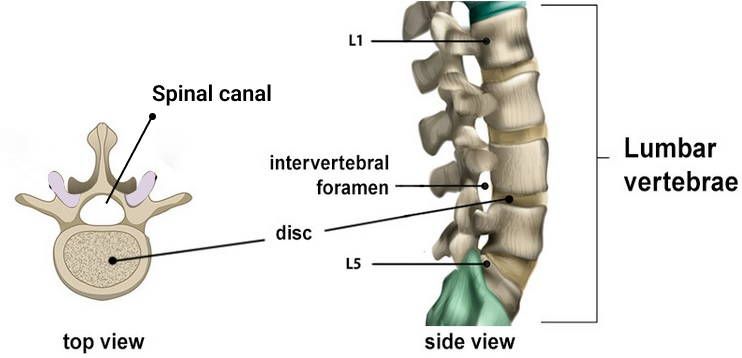Information
A Transforaminal Lumbar Interbody Fusion (TLIF) is a surgical procedure used to address spinal issues in the lower back. Here's how it works:
Spinal Fusion: TLIF involves joining two adjacent vertebrae in the lumbar spine by removing a portion of the spinal disc that separates them. This fusion procedure aims to eliminate motion in the affected spinal segment, reducing back pain.
Disc Removal and Spacer Placement: During the TLIF procedure, the surgeon removes the spinal disc between the two vertebrae. In its place, a spacer or cage is inserted to maintain proper disc height and alignment. This spacer is typically filled with bone graft material to promote fusion between the vertebrae.
Hardware Support: To provide stability and support for the fusion, screws and rods may be used to secure the spacer and the adjacent vertebrae.
Compression Relief: The placement of the spacer and the fusion process help create more space for the nerves in the spinal canal, relieving compression. This can alleviate symptoms such as sciatica, back pain, and leg pain.

TLIF surgery is considered for individuals with specific spinal conditions that require stabilization and fusion of the affected vertebrae. The procedure aims to reduce pain and improve the overall function of the lower back.
Is TLIF a major surgery?
TLIF surgery is generally considered a major surgical procedure.
General Anesthesia: TLIF surgery is performed under general anesthesia.
Invasive Nature: The surgery involves making incisions, removing part of the spinal disc, placing a spacer, and securing it with screws and rods.
Spinal Fusion: TLIF surgery aims to achieve spinal fusion, which is a complex and major process involving the joining of two vertebrae.
While TLIF is indeed a major surgery, there are minimally invasive TLIF techniques that can reduce surgical invasiveness and potentially improve recovery rates. Minimally invasive approaches typically involve smaller incisions, less disruption to surrounding tissues, and potentially shorter recovery times. However, the decision on the approach used will depend on the specific condition being treated and the surgeon's expertise.
Here are few types of TLIF procedures:
Traditional TLIF: This is the standard TLIF procedure, where the surgeon accesses the spinal disc through a posterior (back) approach. It involves removing the disc, placing a spacer or cage filled with bone graft material, and using screws and rods for stabilization.
Minimally Invasive TLIF (MIS-TLIF): This technique aims to minimize surgical invasiveness. It involves smaller incisions, reduced disruption to surrounding tissues, and potentially quicker recovery times compared to traditional TLIF.
Oblique TLIF (OTLIF): OTLIF is a variation of TLIF that uses an oblique or angled approach to access the spinal disc. This approach may provide improved access to the disc and reduce the risk of injury to surrounding structures.
Lateral TLIF (LLIF or XLIF): Lateral TLIF is performed through a lateral (side) approach. It allows the surgeon to access the disc from the side, avoiding the need to navigate through the back. This approach is less invasive and may be suitable for certain patients.
Endoscopic TLIF (ETLIF): ETLIF is a minimally invasive procedure that uses an endoscope and small incisions to perform the TLIF. It provides real-time visualization of the surgical site and potentially reduces tissue disruption.
The choice of TLIF procedure depends on the specific spinal condition being treated, the patient's anatomy, and the surgeon's expertise. The goal of all TLIF procedures is to achieve spinal fusion, alleviate pain, and improve the overall function of the spine.
Benefits
Some of the key benefits of Transforaminal Lumbar Interbody Fusion (TLIF) include:
- Spinal Stability: TLIF is an effective method for achieving spinal fusion, which stabilizes the affected spinal segment. It helps eliminate abnormal motion, reducing pain and preventing further degeneration.
- Symptom Relief: TLIF can alleviate various symptoms associated with spinal conditions, such as back pain, leg pain, numbness, and weakness. By decompressing nerves and addressing the underlying issue, it can significantly improve a patient's quality of life.
- Improved Function: Patients often experience improved physical function after TLIF surgery. The procedure can restore mobility and enhance the ability to perform daily activities without pain or limitations.
- Minimally Invasive Options: Minimally invasive TLIF techniques are available, which involve smaller incisions, reduced tissue disruption, and potentially quicker recovery times compared to traditional open surgery.
- High Success Rates: TLIF surgeries have shown high success rates, with a significant percentage of patients reporting improved outcomes and satisfaction with the procedure.
- Long-term Benefits: TLIF is intended to provide long-lasting relief and stability. By promoting spinal fusion, it reduces the risk of recurrent symptoms and the need for future surgeries.
- Customized Approach: TLIF procedures can be tailored to the patient's specific spinal condition, allowing for a personalized treatment plan.

It's essential for individuals considering TLIF to consult with a qualified healthcare provider to determine whether the procedure is appropriate for their condition and to discuss potential benefits, risks, and expected outcomes.
If You Have Decided to Have Surgery:
These are essential steps to follow when preparing for surgery, as they help ensure a safe and successful procedure. It's important to adhere to your healthcare provider's recommendations and instructions before surgery. Here's a brief summary of the key steps:
- Contact Endospine360 Experienced Spine Surgeon to set a date for your surgery and pre-operative consultation.
- Meet with the doctor to discuss the surgical procedure, address any questions or concerns you may have, and provide informed consent for the surgery.
- Your doctor will provide you with prescriptions for pain medication and detailed instructions for post-operative care. It's crucial to understand and follow these guidelines.
- Pre-operative Evaluation: Your evaluation may include chest X-rays, ECG (electrocardiogram), ECHO (echocardiogram), and blood work to assess your overall health and readiness for surgery.
- If you take daily aspirin or blood-thinning medications, your doctor will advise you to stop them at least five days before surgery to reduce the risk of excessive bleeding during the procedure.
- If you are a smoker, it's strongly recommended to make every effort to quit smoking at least two weeks before surgery. Smoking can have adverse effects on the healing process and overall surgical outcomes. It's also crucial to refrain from smoking for at least six weeks after surgery.
Surgical Procedure:
A detailed overview of the surgical procedure for TLIF (Transforaminal Lumbar Interbody Fusion) :
- Anesthesia: The anesthesiologist will administer general anesthesia to put you to sleep for the operation.
- Incision: An incision is made in the middle of your lower back. The length of the incision depends on the number of spinal levels that need to be decompressed and treated.
- Retractor: A retractor is placed to gently move the muscle tissue aside and expose the back of the spine.
- Laminectomy: The bone and ligament that are causing pressure on the spinal canal are removed. This is the laminectomy portion of the procedure.
- Discectomy: If a discectomy is required, the pinched nerve is gently moved to the side, and the bulging or herniated disc material is removed from underneath the nerve.
- Fusion: For the fusion, bone graft material is packed around the spine's bones to facilitate the fusion process. Bone can be taken from your pelvis, or synthetic bone graft may be used.
- TLIF Procedure: In the case of TLIF, where the entire disc is removed, it is replaced with a plastic cage filled with bone graft.
- Screws and Rods: If screws and rods are needed for stability, they are placed into the bone and tightened.
- Drainage Tube: In some cases, a drainage tube may be inserted beneath the muscles before closing the incision to manage any blood or drainage accumulation. It is usually removed on the 1st or 2nd day after surgery, depending on the amount of drainage.
- Closure: The incision is closed with resorbable stitches that are placed beneath the skin.
The surgery typically lasts around 3-4 hours, although the duration can vary depending on the complexity of the procedure and the number of spinal levels involved. It's a comprehensive process aimed at relieving pain, decompressing nerves, and promoting spinal fusion for stability and long-term relief.
After Surgery:
The post-operative care and recovery process after TLIF surgery involves several key steps:
- Recovery Room: You will spend about 2-3 hours in the recovery room following the surgery. During this time, the medical team will monitor your condition.
- Doctor's Discussion: The doctor will communicate with your family while you are in the recovery room to provide updates on the surgery and your condition.
- Early Mobilization: The nursing staff will assist you in getting out of bed shortly after surgery. A physical therapist may also work with you to assess your strength and mobility.
- Rest and Gradual Activity: Typically, you are advised to rest on the day of the procedure. However, early mobility is encouraged:
Day 1-2: Sitting is initiated.
Day 2-3: You start standing and walking.
Day 3-4: Continue walking within the hospital room for necessary activities. - Discharge: Depending on the specifics of your case, you may be discharged from the hospital around Day 4. This duration can vary, with a shorter stay if fusion is not performed and a slightly longer stay if fusion is part of the procedure.
- Dressing and Drain Removal: The surgical dressing is usually changed, and the small drain is removed on the 2nd or 3rd morning after surgery. This dressing will remain until your follow-up visit with the doctor, scheduled two weeks after surgery.
- Ambulation with Belt: You will be advised to use a brace whenever you are out of bed for the first 6 weeks. This brace helps support your back during early stages of healing.

Regular follow-up appointments are also crucial for monitoring your progress and addressing any concerns during the recovery period.
After Going Home:
Pain Medication: You will receive prescribed pain medication and muscle relaxants to manage post-operative pain and muscle spasms. It's important not to operate heavy machinery or drive while on these medications.
Driving: You may typically resume driving once you are off your pain medications, which is generally around 4-6 weeks after surgery.
Return to Work: If you have a sedentary office or desk job, you can expect to return to work approximately 4-6 weeks after surgery. However, if your occupation involves manual labor with heavy lifting, frequent bending, or climbing, it's advisable to wait 6 months before returning to this activity. You can gradually transition to moderate-duty tasks at 6 weeks.
X-ray Monitoring: X-rays will be taken at each of your post-operative visits. These appointments are typically scheduled at 2 weeks, 6 weeks, 3 months, and 6 months after surgery. The imaging helps your doctor assess the progress of fusion and healing.
Fusion Assessment: By the six-month post-operative visit, the fusion is often seen to be solid, indicating a successful outcome.
Resumption of Sports Activities: You can generally resume sports activities like golf or tennis at 6 months, provided that the fusion is confirmed to be solid. The timing may vary depending on individual recovery and the specific guidance from your doctor.
It's crucial to adhere to the recommended activity restrictions and attend your follow-up appointments to ensure a safe and successful recovery after TLIF surgery. Following your doctor's guidance during the recovery period is essential for the best long-term outcomes.


